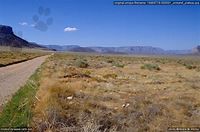The Grand Canyon… Billions of Years Old- Or Thousands of Year Old?
How Geologists Date the Grand Canyon
- Geologists believe the Grand Canyon was formed by the gradual removal of earth by the Colorado River.
- They measure the amount of debris per year that the Colorado River removes from the bottom of the Grand Canyon.
- They then use this rate to calculate 70 million years as the time needed to remove the earth down to its present depth.
- Scientists call this method of dating “uniformitarian” on the basis that the Colorado River has always removed earth from the Canyon at the same rate.
B. Refutation of Geologists’ “Uniformitarian” Method of Dating the Grand Canyon
- Steven Austin, PhD in Geology and chairman of the department of Geology at Creation Research Institute, has researched the 1980 eruption of the Mt. St. Helens volcano and found scientific evidence that refutes geologists’ “Uniformitarian” method of dating the Grand Canyon at 70 million years.
- Dr. Austin found that the 1980 eruption of the Mt. St. Helens volcano formed 5 canyons in 5 days. The canyons averaged a depth of about 100 feet, 1/40th the size of the Grand Canyon.
- The largest canyon was 125 feet deep, 1,500 feet wide and 3,200 feet long, and was gouged out of solid rock laid down by an ancient lava flow.
- The second steam blast leveled a forest of 150 square miles in 6 minutes and deposited 150 feet of land slide and volcanic ash, leaving 65 feet of mud 1/4th of a mile wide.
- The volcano explosion caused 600 feet of strata to form in the different canyons, a phenomenon that modern geologists attribute normally to hundreds of millions of years on the basis of “Uniformitarianism.”
- Volcanoes also exist on top and around Grand Canyon explaining how eruptions during the last 5,000 years could easily cause much of the depth of the Grand Canyon, plus many of the layers of sediments found in the walls of the canyon.
- With the added world-wide catastrophe of the Flood of Noah’s days, the present depth of the Grand Canyon and the multiplied layers of sediment in the canyon walls are easily explained.
C. Geologists’ Claim the Rocks in the Strata of Grand Canyon Vary in Age from 10 Million to 2.6 Billion Years
34 Steven A. Austin, Grand Canyon, Monument to Catastrophe, 1994, p. 88.
35 Mt. St. Helens: Explosive Evidence for Catastrophe Video on site, Institute of Creation Research, 1994.
1. Geologists use the following radiometric methods of dating rocks.
- Rubidium-87 has a half-life to 48.8 billion years, decaying into strontium-87.37
- Uranium-238 has a half-life of 4.47 billion years, decaying into lead-206, and is “useful for the time period between 100,000 and 1,200,000 years.”
- Potassium-40 has a half-life of 1.25 billion years and gradually decays into Argon-40 and Calcium and dates rocks from 20,000 to 4.5 billion years.
2. Geologists used all three of these methods to date the rocks of different strata of Grand Canyon between 10 million and 2.6 billion years.
3. Geologists thus conclude that the dates of the rocks of these strata confirm the 70 million-year process of the formation of the Grand Canyon by removal of strata by the Colorado River.
D. Weaknesses of Radiometric Dating
1. Different dating methods used on rocks in the same (top) strata of the Grand Canyon differ in their dates by 2.59 billion years.
- The Potassium/Argon method gave dates between 10 million and 117 million years.
- The Rubidium/Strontium method gave varied ages between 1.27 and 1.39 billion years.
- The Uranium/Lead method gave an isotope age of 2.6 billion years, 1.26 billion years older than the age indicated by the Rubidium/Strontium method and 2.59 billion years more than the youngest date of the Potassium/Argon method.

2. The rocks in the older (lower) strata (Cardenas Basalt and Diabase Sills) are located one mile below the

Uinkaret Plateau. These two strata are both Pre-Cambrian (before life appeared on earth).
- These Pre-Cambrian rocks dated between 715 million and 1.07 billion years.43
- Thus, the top, youngest layer of the Grand Canyon has rocks that are dated older by 130 million to 1.5 billion years than the Pre-Cambrian rocks at the bottom of the Grand Canyon.
- Geologists tell us that the lowest or oldest strata must contain the oldest rocks and yet the plateau one mile above the canyon contains the oldest rocks.
- These contradictory dates for Grand Canyon rocks demonstrates that radiometric methods are not reliable in dating rocks.
3. Diamonds from Zaire were dated by the potassium/argon method at 6 billion years, a billion years older than the earth is dated, again proving the inadequacy of this radiometric method of dating.
4. 200-year old lava flows in Hawaii were dated by the potassium/argon method at 3 billion years old, 2.9999 billion years more than reality.
5. These enormous differences in radio-active dating demonstrate that the radiometric methods are unreliable
37 Steven A. Austin, Grand Canyon, Monument to Catastrophe, 1994, p. 113.
38 New Encyclopedia Britannica,1991 Ed., 12.196.
39 New Encyclopedia Britannica,1991 Ed., 9.640-1.
40 Steven A. Austin, Grand Canyon, Monument to Catastrophe, 1994, p. 126.